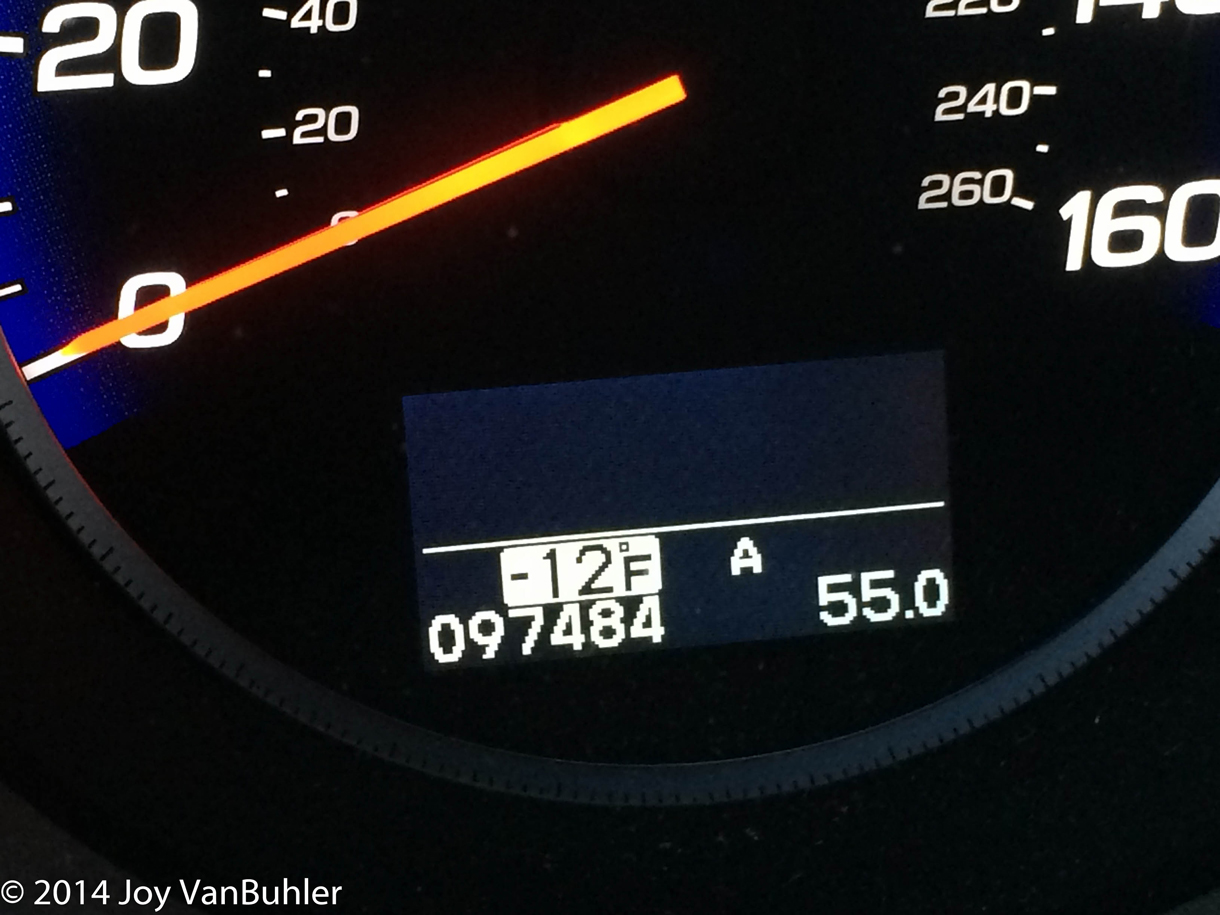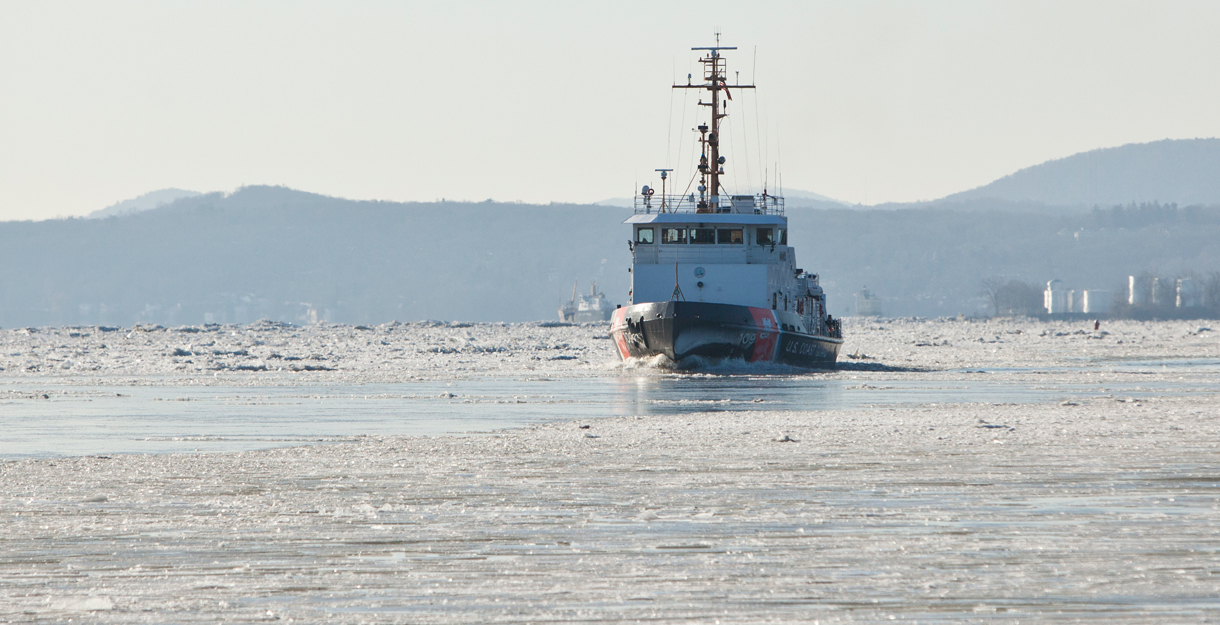January 10, 2014
Air Date: January 10, 2014
FULL SHOW
SEGMENTS
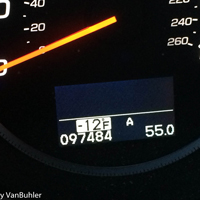
White House Confronts Climate Deniers
View the page for this story
Some skeptical pundits have used the recent cold snap to suggest that climate change isn’t real. But in a video posted online, White House Science Advisor John Holdren says that because of climate change we should expect more extreme weather –-hot and cold--in the years to come. (02:05)
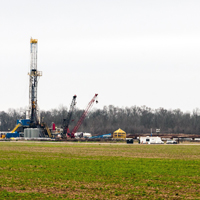
Groundwater Contamination on Fracked Land
View the page for this story
Natural gas is booming in the United States but many are concerned about the safety of extraction. A new AP study in four states finds hundreds of complaints blaming drinking water contamination on fracking, and AP reporter Kevin Begos tells host Steve Curwood all about it. (06:00)
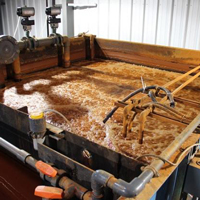
Fracking With Recycled Mine Water
View the page for this story
Thousands of abandoned mines in Pennsylvania are full of polluted water. Now the fracking boom is is being seen as a way to pay for cleaning up that water by reusing it. Reid Frazier reports. (05:30)
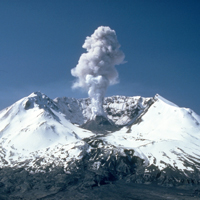
The Pros and Cons of Geoengineering
View the page for this story
In a bid to avoid some of the worst effects of climate change some scientists are advocating possible strategies to artificially alter the climate. But critics warn of unforeseen and dangerous consequences of any atmosphere altering intervention. David Keith from Harvard University and Clive Hamilton of Charles Sturt University in Australia debate the case for each side with host Steve Curwood. (17:10)
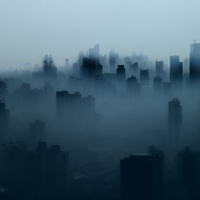
Air Pollution and Diabetes
View the page for this story
We’ve long known that air pollution is bad for our lungs and can even cause cardiovascular disease, but as Doctor Sanjay Rajagopalan tells host Steve Curwood, recent research suggests that breathing dirty air in combination with a fatty diet can promote diabetes. (07:00)
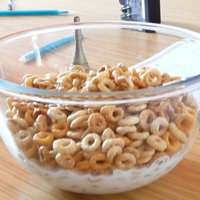
Beyond the Headlines – Cheerios go’s GMO-free
View the page for this story
In this week’s trip beyond the headlines, Peter Dykstra brings us stories of a popular cereal going totally GMO free, solar power as a darling of Wall St, and the anniversary of a bizarre industrial accident. (05:30)

Prairie Rattlesnake
View the page for this story
A few months ago writer Mark Seth Lender met his first Prairie Rattlesnake up close and personal, and found the snake fascinating, and though venomous, not a threat. (03:40)
Show Credits and Funders
Show Transcript
Host: Steve Curwood
GUESTS: Kevin Begos, David Keith, Clive Hamilton, Sanjay Rajagopalan,
REPORTERS: Reid Frazier, Peter Dykstra, Mark Seth Lender
[THEME]
CURWOOD: From Public Radio International, this is Living on Earth.
[THEME]
CURWOOD: I’m Steve Curwood. The recent record cold in North America has prompted some to question climate change, so the country's chief scientist weighs in.
HOLDREN: If you've been hearing that extreme cold spells like the one that we're having in North America disprove global warming, don't believe it. The fact is that no single weather episode can either prove or disprove global climate change.
CURWOOD: Presidential science advisor John Holdren explains what's going on. Also, particulate matter in air pollution has some startling extra dangers.
RAJAOPALAN: What we found was if you are consuming high fat diet and on top of that you are inhaling particulate matter this markedly increases your susceptibility to eventually developing type 2 diabetes.
CURWOOD: We'll have that and more this week on Living on Earth. Stick around.
[NEWSBREAK MUSIC: Boards Of Canada “Zoetrope” from “In A Beautiful Place Out In The Country” (Warp Records 2000)]
ANNOUNCER: Funding for Living on Earth comes from Stonyfield Farm. Makers of organic yogurt, smoothies and more.
White House Confronts Climate Deniers

An icy morning in Chicago (photo: sierraromeo)
CURWOOD: From the Jennifer and Ted Stanley Studios in Boston this is Living on Earth. I’m Steve Curwood. The mercury plummeted this past week as a “polar vortex” gripped the middle of the country with arctic temperatures. Given the deep freeze, several pundits have been arguing that climate change isn't real. But the White House Science Advisor begs to differ. Though he's quick to point out that no one weather event can directly be attributed to global warming, Nobel Prize-winning physicist John Holdren explains in a prerecorded video that extreme temperatures could be the new normal precisely because of climate change.
HOLDREN: But a growing body of evidence suggests that the kind of extreme cold being experienced by much of the United States as we speak is a pattern that we can expect to see with increasing frequency as global warming continues, and the reason is this.
In the warming world that we’re experiencing, the far north, the Arctic, is warming twice as rapidly as the mid-latitudes such as the United States. That means the temperature difference between the Artcic and the mid-latitudes is shrinking, and that temperature difference drives what is called the “cirumpolar vortex” which is the great counter-clockwise swirling mass of cold air that hovers over the Arctic. As the temperature difference between the Arctic and the mid-latitudes declines, the polar vortex weakens, and it becomes wavier. The waviness means there can be increased larger excursions of cold air southward, that is into the mid-latitudes, and in the other phase of the wave, increased excursions of relatively warmer mid-latitude air into the far north.
Computer models tell us there are many different factors influencing these patterns and as in all science, there will be continuing debate about exactly what is happening. But I believe the odds are that we can expect as a result of global warming to see more of this pattern of extreme cold in the mid-latitudes, and some extreme warm in the far north.
CURWOOD: White House Science Advisor John Holdren.
Related links:
- Check out the White House video here
- Read more about President Obama’s climate action plan
- Check out some amazing photos of the polar vortex from Mother Jones
Groundwater Contamination on Fracked Land
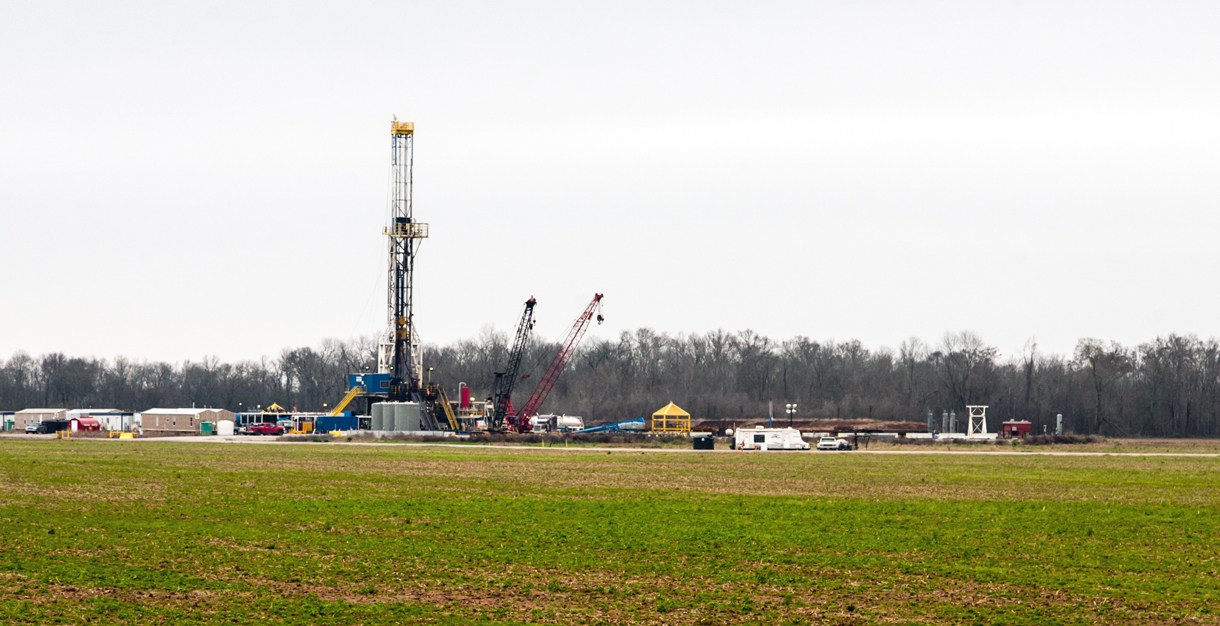
Natural gas fracking in Louisiana (Daniel Foster)
CURWOOD: Now the increased development and use of natural gas is part of the White House's "all of the above" strategy for addressing climate change. But while natural gas burns much cleaner then coal or oil, the hydraulic fracturing, or fracking used to extract the gas from deep underground has generated controversy, especially its impact on water. Fracking uses huge quantities of water and there are also concerns that it can foul the underground reservoirs of water that people tap for wells. Now an investigation by the Associated Press has documented hundreds of complaints of drinking water contamination near fracking operations in Pennsylvania, Texas, Ohio, and West Virginia. And Kevin Begos, an AP reporter based in Pittsburgh, says at times government authorities have tried to block the release of this information.
BEGOS: We started asking these questions two years ago. One of my colleagues, Michael Rubinkam, tried to get records from Pennsylvania on the contaminations and complaints, and we had a long series of legal battles to get them under the state’s “right to know” law. But then we just tried asking four states to give us their most recent documents on the number of complaints. You know, we didn’t file a lawsuit or “right to know”, we just acted as if we were an average member of the public or a journalist starting from scratch.
CURWOOD: So what exactly did they give you, these four states?
BEGOS: We were surprised that it varied widely. Texas gave far more data, for example; the data of each complaint, the well location, summary, the type of complaint, the status of the complaint. Ohio, West Virginia and Pennsylvannia more just gave very rough summaries; “here’s the numbers of complaints we have, here’s the numbers we’ve confirmed,” but there’s still a lot of unknowns about the Pennsylvania data and the other states.
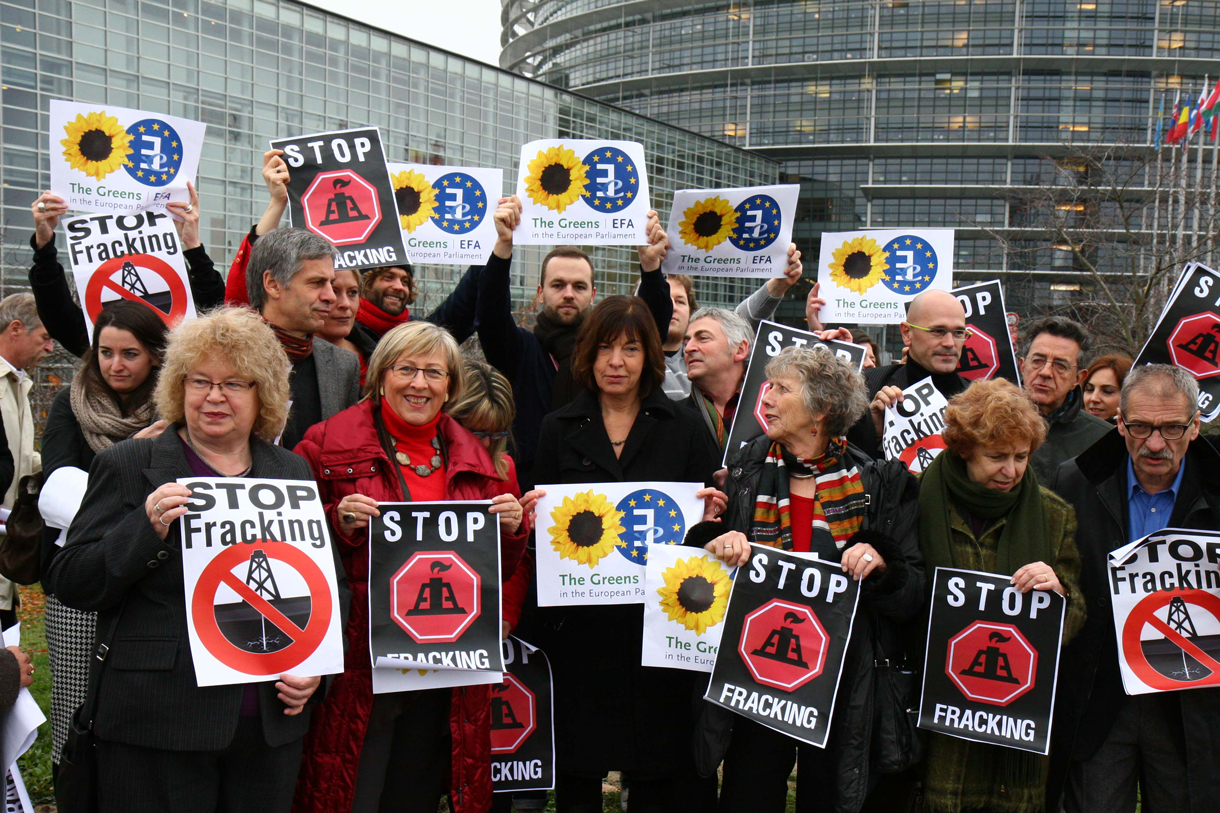
Fracking protest (photo: greensefa)
CURWOOD: How many complaints did you find records of?
BEGOS: Pennsylvannia has 398 in 2013 and 499 in 2012. Ohio has, starting in 2010, 37 and it went up to 54, then 59 in 2012. West Virginia had a total of 122 complaints over the past four years. Texas had a smaller number, 62 water well complaints even though they had more than 2,000 complaints in general about oil or gas drilling impacting property.
CURWOOD: And of those complaints, how many were deemed valid by the state?
BEGOS: Pennsylvannia’s comfirmed at least 106 since 2005. Texas says they’ve confirmed none of the alleged water well contaminations. West Virginia said four cases. The evidence was strong enough that the driller took corrective action, and Ohio has six confirmed cases. So one of the big questions is, are these investigations rigorous enough? How have they been conducted? Is this a realistic snapshot of how many people really have problems?
CURWOOD: What kind of contamination are we really talking about here for water wells?
BEGOS: Some of the best researchers have been finding that methane seems to be by far the most common problem. There’s been tremendous debate over whether any of the fracking chemicals get into water wells, but in practical terms a lot of people are having much simpler problems, just things, for example, something spilling on the surface and going into a creek or impacting a well...or the methane, excessive natural gas in a well. So it’s really not just about the chemicals. It’s sometimes about more run of the mill pollution.
CURWOOD: Excessive natural gas, methane, in a well. What are the odds that it could go boom?
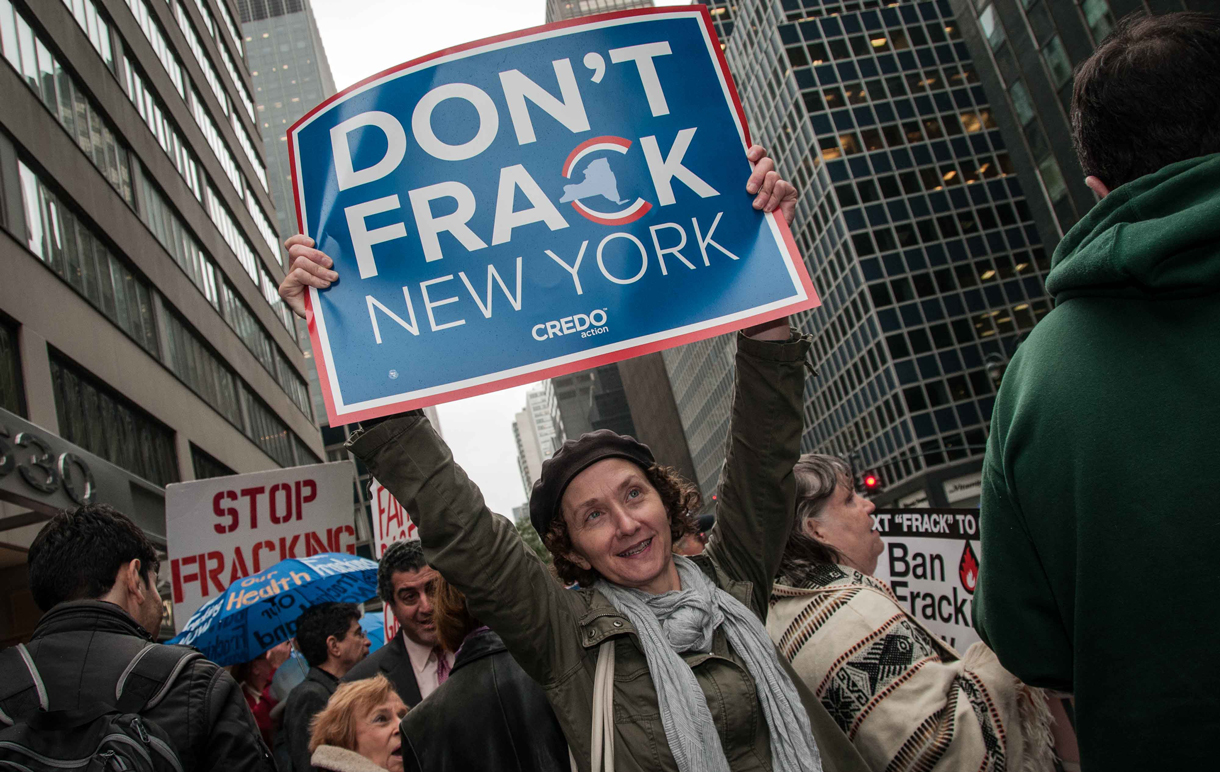
New Yorkers demonstrating against fracking outside of Governor Andrew Cuomo’s office (photo: CREDO.fracking)
BEGOS: They have actually a baseline where they consider the danger of it exploding, and they’re finding small numbers of wells with that excessive high methane, some of them closer to natural gas drilling sites. Occasionally some of those natural water wells have very high methane, so that’s what makes it difficult to investigate, separating the background problems from the possibly drilling-related problems.
CURWOOD: This body of complaints that you found in Pennsylvannia. What’s your sense of how many wells might in fact be affected, as opposed to people speaking up?
BEGOS: See, that’s where it’s impossible to speculate, and that was really the bigger point we’re making. Anyone can guess at these things or give opinions that hardly any of them are contaminated or any of them are contaminated. But that’s just guesswork. There really needs to be more disclosure so that question can be answered. And that’s what makes people fearful, some of the experts have said, is that the uncertainty is perhaps even worse than whatever the truth is.
CURWOOD: So after doing all this reporting, what’s your impression of this groundwater question, what’s the takeaway?
BEGOS: You know, one of the experts we spoke to has pointed out that people are incredibly sensitive about groundwater contamination. I mean, there’s all sorts of issues in modern life, air pollution and various water pollutions or things people are worried about, but drinking water pollution really worries people, the potential for it. That’s part of the tremendous concern over fracking. You can’t necessarily see it, it’s happening deep underground, and that makes it harder for people to know what is or isn’t happening, and that’s why people are asking so many questions.
CURWOOD: Kevin Begos reports for the Associated Press from Pittsburgh. Thanks so much, Kevin, for taking the time.
BEGOS: Thank you so much for having me.
Fracking With Recycled Mine Water
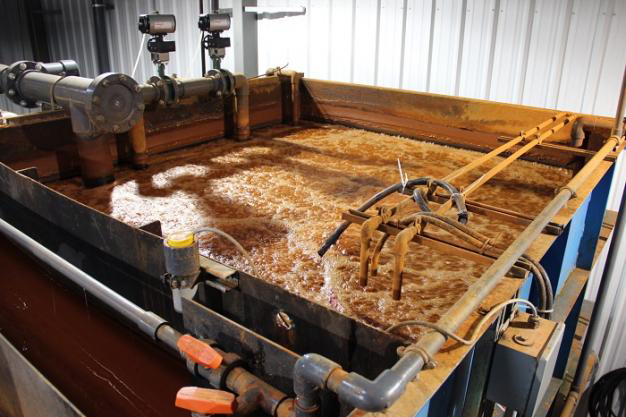
Iron colors the mine water red at the Blue Valley AMD Treatment Center. Money from gas company withdrawals is helping keep the facility working (Photo: Reid R. Frazier)
CURWOOD: One man’s trash is sometimes another man’s treasure, and that may be the case when it comes to water quality issues in Pennsylvania. There are also thousands of abandoned mines that leach metals and other pollutants into the state's streams. And now it appears that fracking could actually be one way to clean up this water, and some in the gas industry are pushing legislation to allow it. Reid Frazier of the public radio program the Allegheny Front caught up with some folks who are demonstrating the potential of recycling old mining water through fracking.
FRAZIER: Bill Sabatose stands in a small industrial building. He’s on a platform, next to what looks like a big hot tub, filled with really dirty water.
SABATOSE: We’re aerating it, we’re trying to oxidize the iron, so you can see how blood red it’s getting.
FRAZIER: The liquid is abandoned mine drainage, or AMD. This AMD came from a mine just up the hill. Sabatose has spent much of his life cleaning up this dirty water. He’s president of the Toby Creek Watershed Association, a local group that built and now runs this facility in northwestern Pennsylvania. The facility passes the AMD through a series of treatments. At the end of the line it flows into a tank the size of an above-ground pool.The water here is clear.
SABATOSE: In this particular tank we’re raising brown trout. A lot of people just love to come up here and just look at them, I guess it mesmerizes them. They just look like a big aquarium.
FRAZIER: The fish will be used to stock streams around the state. The clean water in the tanks eventually runs into the Brandycamp Creek, a tributary to the Allegheny River. Sabatose grew up here, near the town of Brockway. The region has a long mining history. The streams all used to be the color of rust.
SABATOSE: There wasn’t a fish within 100 miles of this place, so it was pretty bad.

Bill Sabatose, president of the Toby Creek Watershed Association, at the Blue Valley AMD Treatment Center in Elk County, Pa. (Photo: Reid R. Frazier)
FRAZIER: Since the group built this treatment plant in 2005 with a state grant, the Brandycamp started getting cleaner. But there was a problem. The watershed group had no idea how it would pay to keep the plant running.
SABATOSE: It was scary because we didn’t have a plan.
FRAZIER: Then around five years ago, a potential solution emerged: fracking. Drillers use millions of gallons of water, along with sand and chemicals, to frack natural gas out of underground rock formations. Frackers typically use freshwater, but a few companies approached Sabatose with an idea. Could they use his cleaned up minewater?
SABATOSE: Well, I thought “there’s all this water, and I need more money to treat all of it”... and I thought, “well, they were looking for water,” and I said ‘try it.’ And they tried it.
FRAZIER: And it worked. The gas companies paid Sabatose’s group for the water, although technically it’s a donation. And with the money the group could treat more abandoned mine drainage. This idea of using old mine water to frack is picking up steam in Pennsylvania. Regulators faced with a $15 billion abandoned mine problem want to see more of this. They see it as one way to get AMD out of streams by putting it in fracked wells. Some companies have already started doing it, but others are balking. Andrew Paterson of the Marcellus Shale coalition say the issue is liability.
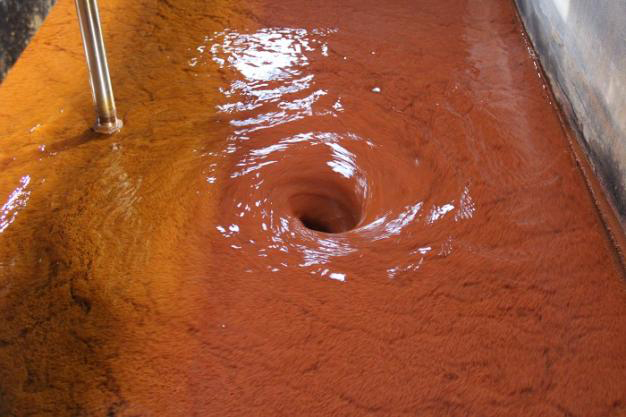
After iron oxides and sulfates are taken out of the mine water, it is discharged into Brandy Camp Creek (Photo: Reid R. Frazier)
PATERSON: The “you touch it you own it” concept.
FRAZIER: He says drillers are worried that they’d be held liable for the condition of the abandoned mine in perpetuity, even if they only used the water for a few months.
PATERSON: It’s not clear on a state or federal basis that if you were to use that water, that by using it you have not inherited the long?term treatment of that source of water.
FRAZIER: Watershed groups like Sabatose’s don’t have to worry about this ? state law protects them from lawsuits over the minewater they treat, because they’re considered good samaritans. A bill being pushed by the gas industry and the DEP would add gas companies to that list of good samaritans.
CARLUCCIO: Well, we see this as a “lose?lose?lose”.
FRAZIER: Tracy Carluccio is with Delaware Riverkeeper, an environmental group. She says gas companies are not good samaritans. Under the bill, companies wouldn’t have to clean up the minewater or buy it from groups like Sabatose’s. They could simply withdraw the water they need from a polluted mine.
CARLUCCIO: They’re not cleaning it up. They’re taking very polluted fluid and making them more polluted.
FRAZIER: But some see this as a way to peck away at the state's historic abandoned mine water problem. Radisav Vidic, an engineer at the University of Pittsburgh, says allowing frackers to use mine water polluted from mines keeps that water from polluting the rivers.
VIDIC: If you think about it, AMD is already killing fish in the streams. If you take it out and prevent it from going into the streams, or if you clean it up before it goes into the streams, you can only make it better.
FRAZIER: Even if the bill passes, no one is promising that fracking will solve the state’s abandoned mine water problems. At current funding levels, cleanup of the thousands of historic coal mines in Pennsylvania is projected to take up to 50 years.
CURWOOD: Reid Frazier brought us that report from the Pennsylvania public radio program the Allegheny Front.
[MUSIC: Bill Frisell “Shacked Up” from Big Sur (Savoy Jazz 2013)]
CURWOOD: Coming up...with carbon dioxide levels higher than they've been in over a million years, we debate taking drastic action to cool the planet. Keep listening to Living on Earth.
[CUTAWAY MUSIC: Booker T: “Father And Son Blues” from Sound The Alarm (Concord Music 2013)]
The Pros and Cons of Geoengineering
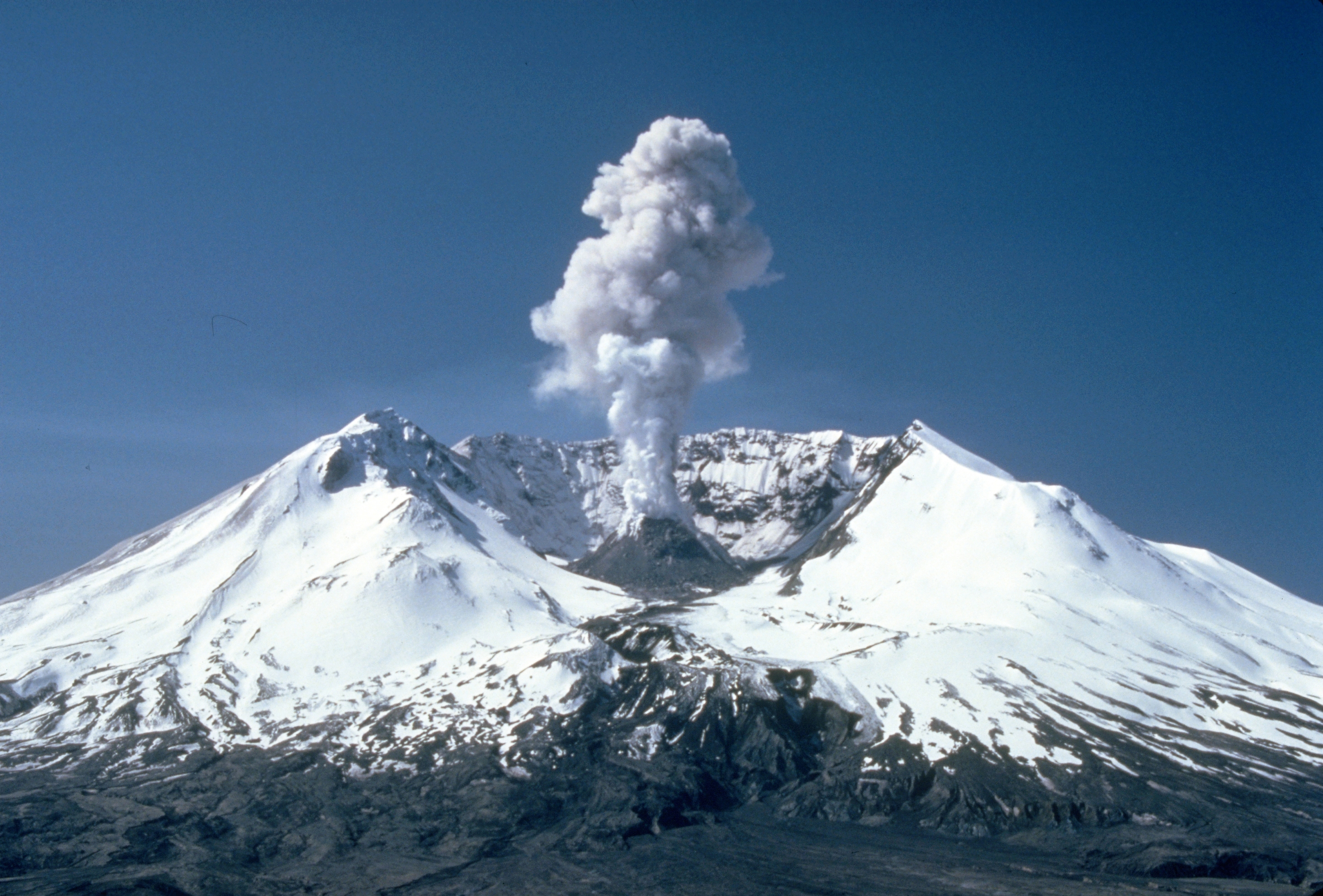
An example of natural geoengineering, volcanic eruptions emit sulfur dioxide, which can cause cooler temperatures. (US Geological Survey)
CURWOOD: It's Living on Earth, I'm Steve Curwood. Since we started farming in the Fertile Crescent over 10,000 years ago, human activities have been altering the climate. But since we started burning vast quantities of fossil fuels about 200 years ago, emissions of CO2 in Earth's atmosphere have soared to levels not known in more than a million years, and heated the planet to levels not seen since civilization emerged. So scientists have started to contemplate the once unthinkable and impossible to find a way to take carbon out of the atmosphere, and cool the planet. And there are ways we might possibly do that.
WOMAN 1: We could plant billions of trees.
MAN: We could use chemical sponges to suck CO2 out of the atmosphere, then bury them.
WOMAN 2: Or we could block some of the sun's heat from the earth with a cloud of droplets of sulfur dioxide.
CURWOOD: Well, some scientists argue that last solution - a solar shield - is the most plausible. They point to the effects of eruptions from volcanoes like Mount Pinatubo for evidence that it works. We've invited into our studio two highly regarded experts with decidedly different views to debate the issue. In what we might call the blue corner is David Keith, who divides his time between Harvard University, and a Carbon Engineering company in Calgary, and is author of a recently published book, A Case for Climate Engineering. David Keith, welcome to Living on Earth.
KEITH: Thanks a lot. Great to be here.
CURWOOD: And over in the red corner, we have Clive Hamilton. He’s a Professor of Ethics at the Centre for Applied Philosophy and Public Ethics at the Charles Sturt University in Canberra, Australia. And his recent book is called Earthmasters: The Dawn of the Age of Climate Engineering.
CURWOOD: Professor, welcome to you.
HAMILTON: It’s good to be here.
CURWOOD: So gentlemen, let’s agree at the very beginning that your views aren’t entirely opposite. In fact, both of you say any attempt at geoengineering would be very serious, even potentially a hazardous step to take, but why do we need to do this? David Keith, sum up for us basically this case for geoengineering.
KEITH: The simple case for taking seriously the idea that we might find technological ways to increase the reflectivity of the Earth, say by putting a kind of pollutant sulfuric acid in the upper atmosphere to reflect away a little sunlight and cool the planet, The significant case for doing that is it appears on technical grounds that it could, in a temporary and imperfect way, substantially reduce the risks for carbon in the atmosphere. It’s one of the few ways we know to materially reduce the risks over, say, the next half century, risks that will fall most on people who are relatively poor and vulnerable living in the hottest parts of the world and also risks to the natural world that is seeing unprecedented levels of climate change.
CURWOOD: Sounds all very reasonable, Clive Hamilton. What’s the problem?
HAMILTON: Well, when we think about it a bit more, the proposal is to coat the Earth with a layer of tiny sulfate particles, to reduce the amount of sunlight that reaches planet Earth. First of all, we’re not actually tackling the problem of climate change, we’re just suppressing one of its symptoms, that is, the warming of the globe, but the other impacts of climate change will continue, for example, and in particular, the continued acidification of the oceans. And one of the biggest problems with this solar shield would be we can’t test it, we can’t do it in a small way to see if it would work in a big way. In order to see if it would actually work in the way anticipated as in David’s book, we would actually have to implement it...install the solar shield, surround the Earth with a layer of sulfate and aerosols, and then sit back and monitor the climate and hope that it worked. But we know the climate system’s incredibly complex. There would be surprises, some of them probably nasty, so that we could actually make the situation worse.
CURWOOD: But what about the fundamental concept here that he’s put forward that, hey, we should be looking at engineering solutions that would ameliorate the effects of climate disruption.
HAMILTON: Well, I think geoengineering is a way of trying to get around a social and political problem with some kind of techno fix. And we’re talking about taking control of the climate system of planet Earth and regulating it to suit our needs. If political leaders believe that they have a technogical solution that will obviate the need to take on big fossil fuel corporations, then they will use it as a substitute for doing what they should be doing, that is, cutting greenhouse gas emissions. If we think about what it means to try and essentially install a thermostat in the climate system it raises the fundamental question of who is going to have their hand on the global thermostat.
CURWOOD: David?
KEITH: I think one thing that Clive does, and did here, is attempt to say that people advocating research in this technology like me are doing it as a way to avoid the social change we need. And to put it simply, it’s nonsense. So there are a lot of reasons why this might be wrong, why my advocacy of this might be dangerous, and I lie awake worried about them and did long before Clive first thought of it.
So the idea that there’s a kind of moral hazard, that this might allow fossil fuel interests to avoid regulation, I believe I’m the one who used that term “moral hazard” in this debate 15 years ago. So I’m hardly unaware of it, but the idea that I and other people working on this somehow think that this can only be done by technology and that we can avoid a social solution is at least in my case, utter nonsense. I’ve just come close to losing my job in Calgary because of clear advocacy that we need social change to eliminate carbon emissions. I think it’s kind of a cheap shot.
I think Clive needs to take seriously the fact that most of the people working on this actually are very serious about the social changes needed, and we may still be wrong to advocate it, but Clive needs to take us on on the reasons we’re wrong, not on a kind of ad hominem attack that we really just like techno fixes and want to as he said in his book “mollify the owners of the fossil fuel infrastructure”. That’s nonsense.
HAMILTON: But I haven’t claimed that at all.
KEITH: Uh, well actually, I’m reading a quote.
HAMILTON: No. I haven’t said that at all. Some of the scientists advocating geoengineering, in fact, most of them, I think, are motivated by the best of concerns, that is they’re deeply concerned about the damage of climate change on people and the natural environment and they’re looking for a solution.
I’m not worried so much about the scientists that are doing work on geoengineering, I’m worried about the political and corporate actors who are drawn to geoengineering as a response to climate change. And so already we see companies like Exxon and Conoco-Phillips and Shell dipping their toes in their water. We see conservative think tanks in Washington saying “Ah-ha! Here’s the answer to climate change. We don’t need to reduce carbon emissions. We can instead deploy these geoengineering solutions.” So it’s not the motive or the work of these scientists in geoengineering that’s the problem. It’s the people who will take it on as a political solution to climate change.
CURWOOD: David?
KEITH: On that score I think the key issue is thinking creatively about how to manage the problem. So specific things like ensuring funding is public, like banning patenting in this area. Like finding specific ways to prevent the kind of technological lock-in, institutional lock-in that will advocate for this solution even if it turns out to be a bad one.
CURWOOD: David Keith, just for the record, um, what funding do you get from the fossil fuel industry?
KEITH: From the fossil fuel industry, zero research funding. For a company that I run called Carbonation Ring, that’s attempting to use methods of getting CO2 out of the atmosphere to develop low carbon fuels, we have some funding from people that are tightly allied to the fossil industry, one of them a guy called Murray Edwards.
CURWOOD: Clive Hamilton, for the record, funding from fossil fuel folks or...
HAMILTON: No. No. No.
CURWOOD: ...well financed opponents of fossil fuels?
HAMILTON: No. I get paid from my university and royalties from the book if it sells.
CURWOOD: David Keith says that your attacks on his position are, well, ad hominem. They’re personal. They ignore the nuance that he has in his book that he’s calling for research on this, that we should understand what the options might possibly be, but to ignore it at this point would be perhaps to do something at our peril.
HAMILTON: Well, firstly, David has gone beyond just calling for research into sulfate aerosol spraying. His latest book says in fact we should pursue a research program, but if the research supports geoengineering’s early promise, then he would choose gradual deployment of the sulfate aerosol spraying. So the worst I would accuse David of is naiviety in thinking that scientists can go ahead with their research program and somehow, now or down the track, quarantine their research from the kind of political use that would be made of the technology should it prove to live up to what he calls its promise.
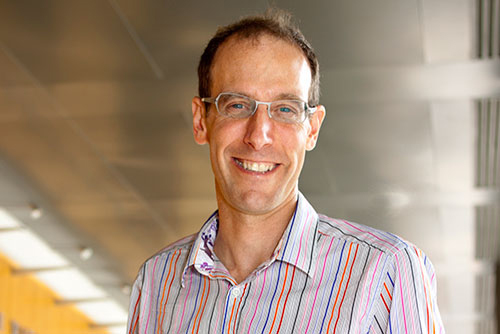
David Keith is a professor at Harvard University and author of A Case for Climate Engineering. (Harvard University)
Because it won’t be David or his fellow scientific researchers who implement, who deploy this solar shield around the Earth, it will be one or more governments. I mean, for example, China is now starting to include geoengineering in its Earth Science research priorities. Russia, in particular, pushed strongly for a strong pro-geoengineering statement in the last IPCC report. So there are lots of political players coming into this domain, and it means these scientists, and most of them including David have perfectly good motives in pursuing this, but it’s naive to think that they’re engaged in pure research which can then be assessed and not be taken up by political actors with sometimes quite inappropriate and even dangerous motivations.
KEITH: It would be completely naive, it would be idiotic to say that. Which is why I and many people have spent a lot of time thinking explicitly about all the ways this research could be used in horrible ways. So going back to the first thing I wrote in the early ’90s, we talked about ways it could be used for war, we talked about ways it could be used to defend interests, I’m actutely and painfully aware of the fact that these are hard political decisions and that the interests of the environmental community who developed them will not be the ones that make the decision.
So I think let’s go beyond this kind of “do we know that or not” and talk constructively about how we deal with that head on, and to be absolutely clear, this in no way is an excuse for cutting emissions. In the long run, emissions stay in the atmosphere for millenia, and if you don’t bring emissions to zero, you will have a climate radically different from today’s. But the fact that geoengineering can reduce the risk in an imperfect way is not argument in itself for ignoring the possibility of reducing that risk.
CURWOOD: So, in other words, you’re not saying to do this instead of reducing emissions, but to do this with the reduction of emissions.
KEITH: Of course, and I’m not just saying it; I’ve invested far more of my personal time in lobbying to cut emissions, and taking personal risks to try and see emission cuts than I have for lobbying for stuff related to geoengineering. But the fact that there’s a trade-off here is not an argument for not using a potentially risk-reducing technology. So if you introduce anti-AIDS drugs, some people will go ahead and have more risky sex, but it would be perverse in the extreme to argue that is a reason not to introduce such drugs.
CURWOOD: David Keith, right now, what would you recommend the United States do in this area of looking at geoengineering? Suppose we weren’t simply talking on the radio program Living on Earth, but we were at the White House. You have the President’s ear and you have just a moment to explain why and how we should do this. What would you say?
KEITH: Have a modest and decentralized research program, and so I would advocate a research program that was very careful to be public, to push out private interests, and be careful the research program spent most of its money actually funding work to find out how it wouldn’t work, and only a small amount trying to develop ways it would work, and I wouldn’t have that in a single institution because government institutions just like private industry suffer from institutional lock-in, and so I would attempt to have a dispersed program, with pros and antis separated.
CURWOOD: Clive Hamilton, how does that sound to you?
HAMILTON: Well, one of the fascinating things about this push for research into geoengineering, particularly, sulfate aerosol spraying, is that we’ve seen a number of conservative think tanks in Washington like the American Enterprise Institute and the Cato Institute, which for years have been denying that climate change exists, have now come out in favor of sulfate aerosol spraying. So, you know, this sounds weird, how can they advocate a solution to a problem they’ve been saying doesn’t exist? And you can see why. Actually their arguments are not about the science, but about ideology. So, whereas climate change represents a drastic failure of the free enterprise system, geoengineering could turn that into a triumph of human ingenuity. Instead of climate change calling on us to be more humble about our relationship to the natural world, geoengineering, the techno fix to beat all techno fixes, promises greater mastery over nature. So you can why those conservative organizations are attracted to this, and that’s why whatever the beneficial motives of those doing the research are politically - there’s a real quagmire here - that could derail the whole process and lead us into a worse world than we’re going to have anyway.
CURWOOD: We’re just about out of time here, gentlemen. But David, Clive is saying that his kind of thinking, that the notion of geoengineering is leading us into a trap at the end of the day.
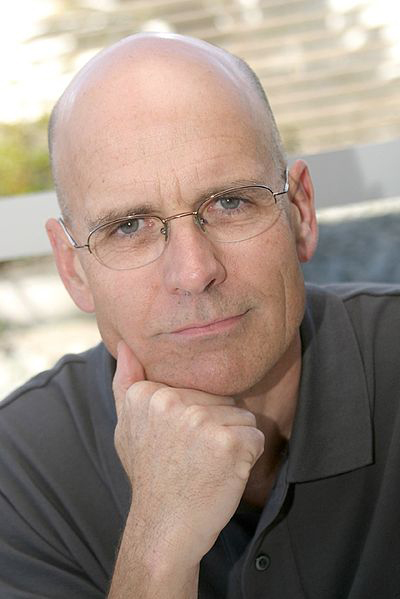
Clive Hamilton is a professor at Charles Sturt University and author of Earthmasters The Dawn of the Age of Climate Engineering. (Clive Hamilton)
KEITH: I think what he’s saying is that it could, and I agree. I think there’s a real risk, that just the thing Clive was talking about will happen. I think the answer is it’s a new thing, and we don’t know what will happen, and it’s splitting the political dynamic in interesting ways. So on the left you see people from the green world who really want to see research in this in a serious way and other ones who dead oppose it. And on the right you see the thing Clive was talking about. What I hope is we can turn the tables a bit on Cato and say well you can’t at the same time say this and deny the science. So let’s cut some kind of deal where you accept a rational reality of science and we move towards to restricting carbon emissions.
CURWOOD: Clive Hamilton, what do you think are the deeper ethical issues of geoengineering?
HAMILTON: One reason why I find geoengineering so fascinating is because it does pose some very big questions about the state that humanity finds itself in. Here we are, transforming the climate system on planet Earth through putting carbon pollution into the atmosphere which is going to completely change the Earth’s system for thousands of years. So what kind of creature have we become when we say the answer to this is to take control of the Earth’s system and regulate it to suit our needs. I think this is a very profound event in human history. Sometimes people use this phrase “playing God”, this idea that we imagine that we are so omniscient and so omnipotent that we can essentially fulfill the role that God traditionally did, and that is to create circumstances in which life on this planet evolved. So I think there’s some big theological, philosophical and ethical questions that geoengineering raises.
CURWOOD: David, did you want to respond to what Clive just said?
KEITH: Yes, not to disagree, but to have a different take maybe. It can never make sense to use kind of engineering methods to make nature more natural. I think there is not an easy answer to that, but this anecdote may be helpful. As a boy I worked on Peregrine falcon introduction with my parents, and that was an engineered system, we built boxes and imported falcons that were bred in captivity from across the country to try to reintroduce them into North America, and that reintroduction program was only conceivable because we had banned DDT, the thing that had killed them. And in fact I would say it worked. We have free living Peregrines now through a combination of DDT and the reintroduction program.
And I think you can ask whether it’s possible to think about that analogy at global scale. It only makes sense to manage climate if we, in the end, bring emissions to zero. But the fact that that’s true doesn’t mean it might not also be worth doing some explicit engineering to try and reduce the rates of climate change.
CURWOOD: Gentlemen, I want to thank you both for taking the time with me today. David Keith’s book is called A Case for Climate Engineering, and Clive Hamilton’s book is called Earthmasters: The Dawn of the Age of Climate Engineering. Thank you both.
KEITH: Thank you.
HAMILTON: Thank you very much.
Related links:
- A Case for Climate Engineering
- Earthmasters The Dawn of the Age of Climate Engineering
[MUSIC: jah Wobble “Car Ad Music 7” from Car Ad Music (Hertz Records 2005)]
CURWOOD: Coming up...news of a surprising link between air pollution, diet and diabetes.
That’s just ahead on Living on Earth. Stay tuned.
ANNOUNCER: Funding for Living on Earth comes from the Grantham Foundation for the protection of the environment. Supporting strategic communications and collaboration in solving the world’s most pressing environmental problems. The Gordon and Betty Moore Foundation. The Kendeda Fund, furthering the values that contribute to a healthy planet, and Gilman Ordway for coverage of conservation and environmental change. This is PRI, Public Radio International.
[CUTAWAY MUSIC: Andy Hamilton “Autumn Groove” from Silvershine (World Circuit Records 1991)]
Air Pollution and Diabetes

Smog over Shanghai. New research suggests that dirty air is contributing to the global diabetes pandemic (photo: bigstockphoto.com)
CURWOOD: It's Living on Earth, I'm Steve Curwood. Now, here is the US, environmental legislation has helped clean up much of the air we breathe, and the recently published EPA standards for new power plants will do even more in the future, if they're implemented. But much of the rest of the world still suffers from bad air. Particulate air pollution is a major health concern for people living in cities around the world, and has long been linked to respiratory and cardiovascular health problems. But now new research out of the University of Maryland suggests a strong link between air pollution, diabetes and high fat diets. Joining us now to explain is Dr. Sanjay Rajagopalan, Professor of Cardiovascular Medicine at the University of Maryland.
RAJAGOPALAN: Now type 2 diabetes, or adult onset diabetes, as some of your listeners might be familiar with, is a pandemic that’s growing in proportion. We don’t understand many of the underpinnings of this disorder. Clearly, we know that physical activity and diet play a role, but there’s increasing interest in a number of environmental factors that might predispose to type 2 diabetes. And we got interested in this primarily because type 2 diabetes clearly alters or increases your susceptability to cardiovascular disease.
A lot of the mechanisms that underlie diabetes and cardiovascular disease are common; inflammation seems to be a common denominator. And since one of the mechanisms by which air pollution modulates your risk for heart disease is through inflammation, we postulated that perhaps this might be playing a role in offering an individual, or in this case, experimental animals, susceptibility to diabetes.
CURWOOD: So, could you describe this study for us? What exactly did you do?
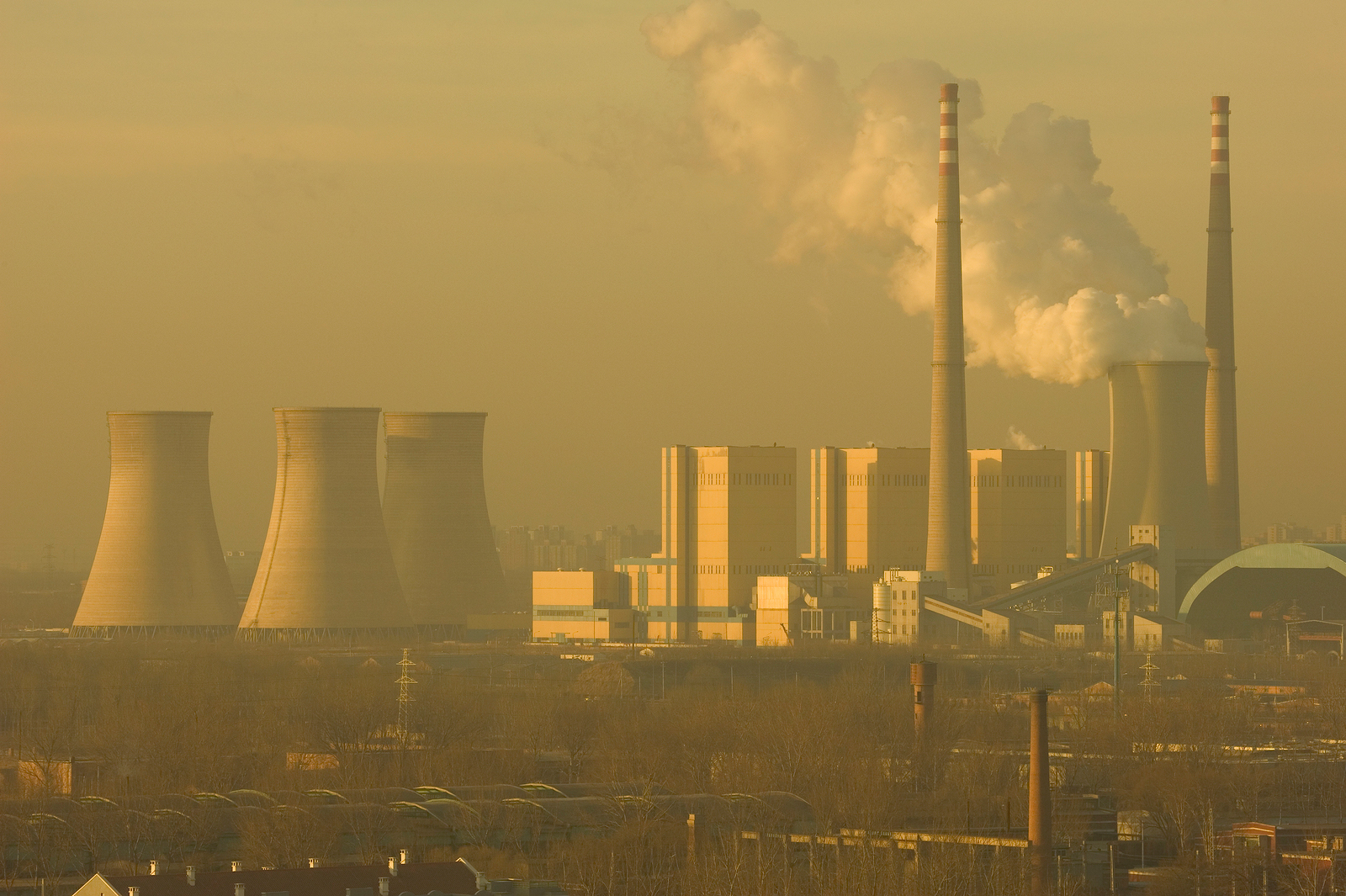
Smog in China (photo: bigstockphoto.com)
RAJAGOPALAN: So this is a follow up of an earlier study that we did several years ago where we showed that when you take sedentary mice that are fed a high-fat diet, and then exposed to air pollution at levels that are very relevant to what an individual might inhale perhaps in a crowded city like Beijing or New Delhi, that over a period of time, these mice develop an exaggeration of the type 2 diabetes. So ordinarily when you expose an individual, or in this case, an experimental mouse to a high-fat diet, they get diabetes after a duration of time. What we found was juxtaposing air pollution inhalation five days a week, as an average commuter from the suburbs to the city might experience, increases the probability or the liklihood of these mice developing diabetes.
So in this study we extended those findings and asked a question to delve into the mechanisms of how this might happen. So we essentially took mice and divided them up into different groups - a group that was exposed to dirty air, a group that was exposed to clean air - and had two interventions where two groups being exposed to clean air and dirty air were fed high-fat diet and the other group was essentially fed a normal diet, or a relatively more healthy diet, and exposed to the same interventions of clean air and dirty air. And what we found was, if you’re consuming high-fat diet, on top of that you’re inhaling particulate matter, this markedly increases your susceptibility to eventually developing type 2 diabetes.
CURWOOD: How much of a difference is it? Twice as likely? Four times as likely?
RAJAGOPALAN: Oh yeah. This magnifies it by approximately two to four fold, so these mice develop diabetes much sooner. The severity of diabetes is accentuated. There was a roughly a doubling of the severity of type 2 diabetes when we put together dirty air in conjunction with high-fat diet.
CURWOOD: Now some people are going to say these are mice. How relevant to people?
RAJAGOPALAN: Oh, very good question. And I would say that since our initial observation, there have been at least 15 studies that have actually extended these observations of experimental models to large populations, and some of these have been done obviously in North America where we live, you know, in a relatively clean environment from an atmospheric standpoint thanks to regulation put together by Congress in the 1970s..but despite that even with the levels you’re exposed to with this continent we still see continuing associations between inhaled particulate matter content and susceptibility to type 2 diabetes. And this has been replicated obviously in countries where the levels are 10 to 20 times higher than what we experience on a bad day in North America. In countries like India, for instance, in China, Indonesia, part of the middle East. These findings have been replicated in a multitude of cohorts and other contexts as well.
CURWOOD: So, at the end of the day, how big of a problem is diabetes globally, and how does that relate to air pollution?
RAJAGOPALAN: Yes, I think the first question is important. I think type 2 diabetes from a global perspective is perhaps one of the most important challenges we as human beings face from a chronic disease standpoint. According to the International Diabetes Federation, the number of type 2 diabetes by 2030 is going to exceed half a billion patients, and this in terms of economic costs, is currently costing in 2012 dollars close to a half trillion dollars in terms of healthcare costs. So this is a humungous problem. Now, from an individual perspective, air pollution does not have as strong of an association with cardiovascular disease as something like hypertension for instance. But from a population level, considering the fact that air pollution is pervasive, it’s present all the time, and nobody is immune to its effects unless you’re living in Antarctica, this becomes a huge population problem.
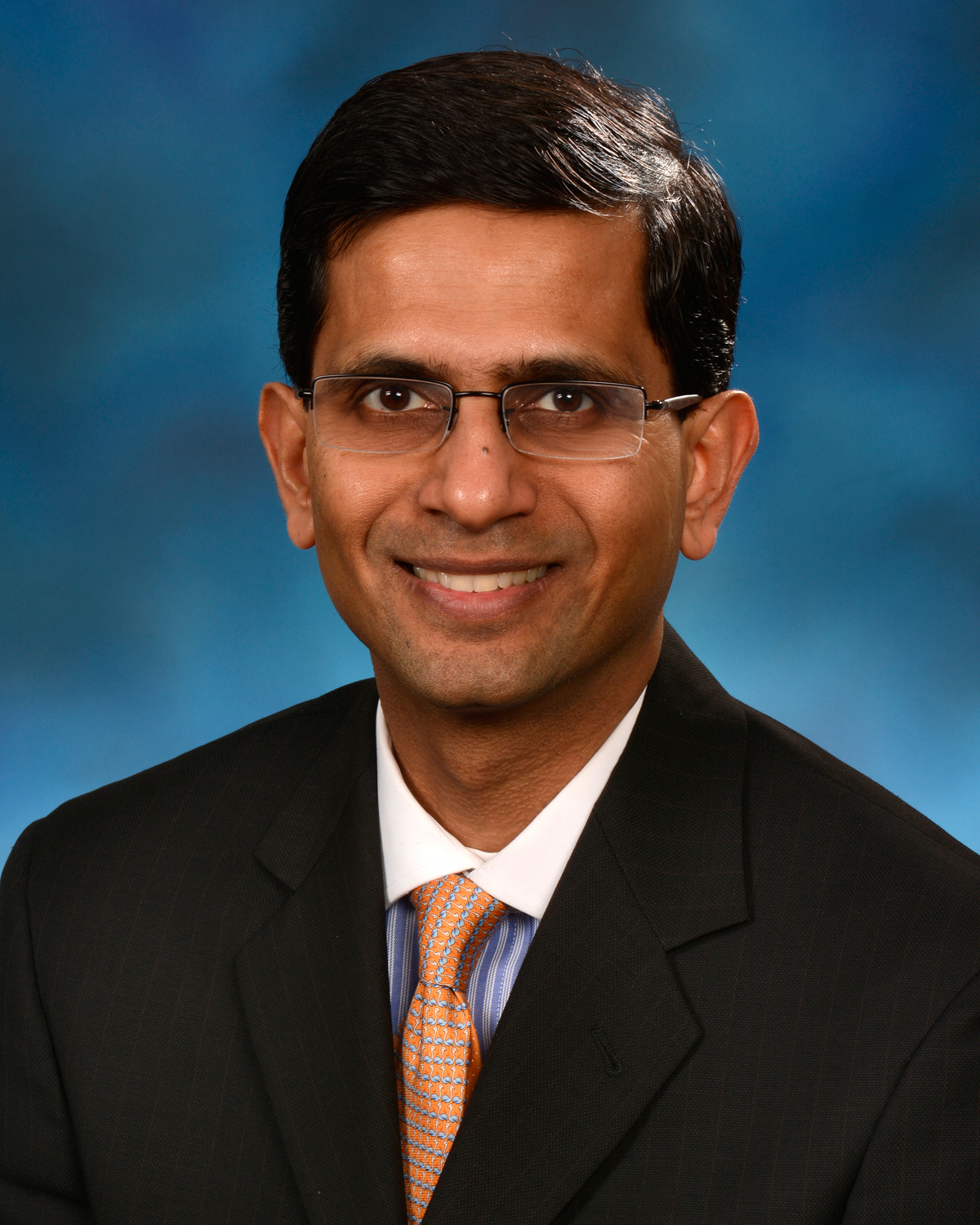
Dr. Sanjay Rajagopalan (photo: University of Maryland)
CURWOOD: In this country, we’ve had a lot of debate over the cost of healthcare. How much should we be considering the environmental factors when it comes to what it costs for us to take care of people?
RAJAGOPALAN: I think environmental factors are going to be center page in these discussions because there’s a growing body of data that’s suggesting that whether it’s water or air or things that you eat, the packages that food is packed in...all of these things have ever so slight effects on your susceptibility to a number of chronic diseases. And these are things that are the reality, but are really the primary prevention measures where if you took care of these issues, you might not have problems to begin with. So these are easy solutions, clearly when you start to think about it, but also equally complex in terms of implementing at a societal level, because it takes so many different stakeholders to agree and to make these changes, you know, it tends to be a lot more complex.
CURWOOD: Dr. Sanjay Rajagopalan is Professor of Cardiovascular Medicine at the University of Maryland at Baltmore. Thank you so much, Professor.
RAJAGOPALAN: Thanks, Steve, for having me on your show.
Related link:
Read more about the study in Environmental Health Perspectives
[MUSIC: Snowboy “Jazzakuti” from The Soul Of Snowboy (Acid Jazz Records 2012)]
Beyond the Headlines – Cheerios go’s GMO-free
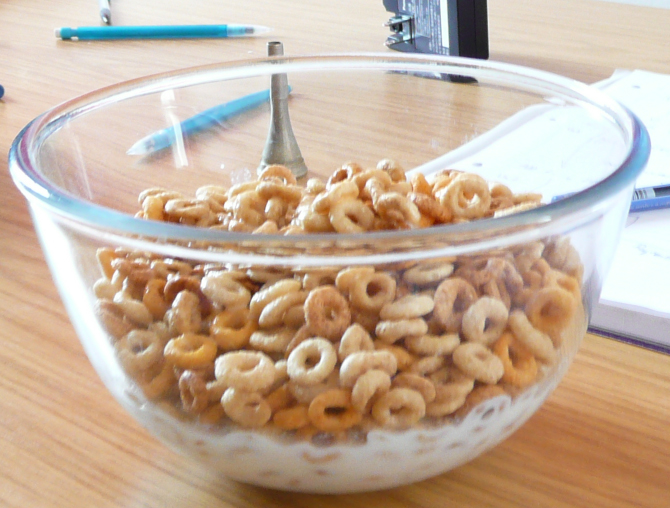
Cheerios, one of the most popular cereals in the United States has always been close to GMO-free because there are no genetically modified oats (photo: Conrad Irwin)
CURWOOD: On the line now from Conyers, Georgia, to look beyond headlines this week is Peter Dykstra, who publishes the DailyClimate.org and Environmental Health News. Hi there, Peter.
DYKSTRA: Hi, Steve.
CURWOOD: What have you got this week?
DYKSTRA: We’re bringing you some big news from the breakfast bowl. Let me ask you a question. Were you a Cheerios kid growing up?
CURWOOD: Of course, weren’t we all?
DYKSTRA: Well, the world’s most iconic, successful, most enduring cereal brand is going GMO-free, Genetically Modified Organisms. It’s a result after a year-long pressure campaign from some anti-GMO activists. GMO products are ubiquitous, most of our corn and soybean products now are genetically modified. Some scientists and millions of consumers are concerned that it’s just not a good way to play with our food.
CURWOOD: Now aren’t Cheerios already sold GMO-free in Europe?
DYKSTRA: Ah, you’re absolutely right. That’s a good point. The primary ingredient in Cheerios - I think anyone who’s ever had them knows - is oats. And there’s no such thing as genetically modified oats. They’re not grown. They’re not produced. They don’t exist, and therefore they’ve never been in Cheerios. For the most part, Cheerios were always GMO-free, but their maker, General Mills, has said it’s going to stop using a few side ingredients like GMO corn starch and sugar in the Cheerios that they sell here in the U.S.
CURWOOD: So it doesn’t seem like General Mills is going all-in on being GMO-free.
DYKSTRA: No, it’s more like they want to have their GMO-free marketing cachet and eat their Count Chocula, too. General Mills is going to pitch and label its Cheerios as being GMO-free. But are the other hand, the same company was helping bankroll the defeat of some state ballot initiatives recently in California and Washington state. Those ballot initiatives would have required that any food products that contain GMOs be labelled. The General Mills company website says they favor a nationwide standard for labeling GMO-free foods, but when it comes to labeling foods that have GMOs in them, they want no part in it and they’re actually working against it.
CURWOOD: So, let’s see here; Cheerios has had few GMO issues to begin with, General Mills is on both sides of the fence of this debate. Peter, could this be more about marketing than food safety?
DYKSTRA: Well, it’s like what we said before. You get the most enduring, most successful, most iconic cereal brand in the world, so yeah, marketing might just have a little bit to do with it.
CURWOOD: Well, let’s see, you found a couple of, may I say, unusual headlines from the past week?
DYKSTRA: Yes, unusual because they’re headlines that I simply never thought I would see in my lifetime, and they both hold some encouraging news for clean-energy advocates. First one, Evanston, Illinois, just north of Chicago, the Walgreens chain built an off-the-grid pharmacy, an entire store that does not depend on the electrical grid. Instead they have 800 solar panels, a couple of wind turbines, a thermal system. The whole place not only saves energy, but they generate 28 percent more than the store uses. That same story which appeared in the Christian Science Monitor says that a PNC bank branch in Fort Lauderdale, Florida, has an energy performance that’s just as good. They’re also striving for off-the-grid status.
The one other headline I’d never thought I’d see came straight from the New York Times, and the headline has these words in it: “Solar Power Craze on Wall Street.” The focus is on Elon Musk, he’s the guy that helped start PayPal and make it a success. He founded the Tesla electric car company. He’s a new venture, called “Solar City”, it’s now the largest producer of home rooftop solar arrays in the US. His company’s stock has grown sevenfold since they launched a few years ago.
CURWOOD: Wait a second here, Peter, I seem to remember that a lot of financial “crazes” and bubbles don’t work out so well.
DYKSTRA: Yes, you’re right. I mean, Solar City has arrived financially. This headline, “Solar Power Craze on Wall Street.” is kind of a good thing to put on the wall. But in the end, like a lot of crazes, they might get carried out in a coffin just like the internet bubble and the housing bubble. You can even go back to the 17th century and look at the tulip craze that wiped out investors in Holland, but you can’t succeed financially if you haven’t arrived financially, and here’s a sign that solar may have arrived.

The Great Molasses Flood of 1919 in Boston (photo: unknown, public domain)
CURWOOD: Finally, Peter, what’s on the anniversary calendar for this week?
DYKSTRA: Well, I’m not going to call it my “favorite” industrial accident of all time because people died in this one, and saying that it’s your favorite is a little bit like hitting the “like” button on Facebook after you read someone’s obituary.
But it was 95 years ago this week, it happened in Boston, it happened not too far from the Jennifer and Ted Stanley Studios where you put the show together, and it was the Great Molasses Disaster of 1919. It happened when the temperature abruptly rose from zero to 40 degrees in just a few hours.
CURWOOD: We've had a fair amount of that this winter right here in Boston.
DYKSTRA: And they had it in 1919 as well. What happened after the temperature rise is that this immense tank full of molasses, this two and a half million gallons of molasses ruptured, it fell apart, the molasses came out, it wiped out two city blocks, flattened buildings and killed 21 people, this fast moving, heavy, sticky tsunami of molasses. Like I said, I can’t call it my “favorite” accident, but it’s certainly one of the most bizarre.
CURWOOD: So it wasn’t moving as slow as molasses in January then?
DYKSTRA: You're right, it's the deadly exception to the rule.
CURWOOD: Thanks so much, Peter.
DYKSTRA: Thanks, Steve, talk to you soon.
CURWOOD: You can find links to all these stories at our website, LOE.org.
Related links:
- Check out the off-the-grid Walgreens
- Read the New York Times story on the solar craze
- Follow Peter Dykstra on Twitter
[MUSIC: Robert Glasper “Letter To Hermione” from Black radio (Blue Note Records 2013) Happy Birthday David Bowie]
Prairie Rattlesnake
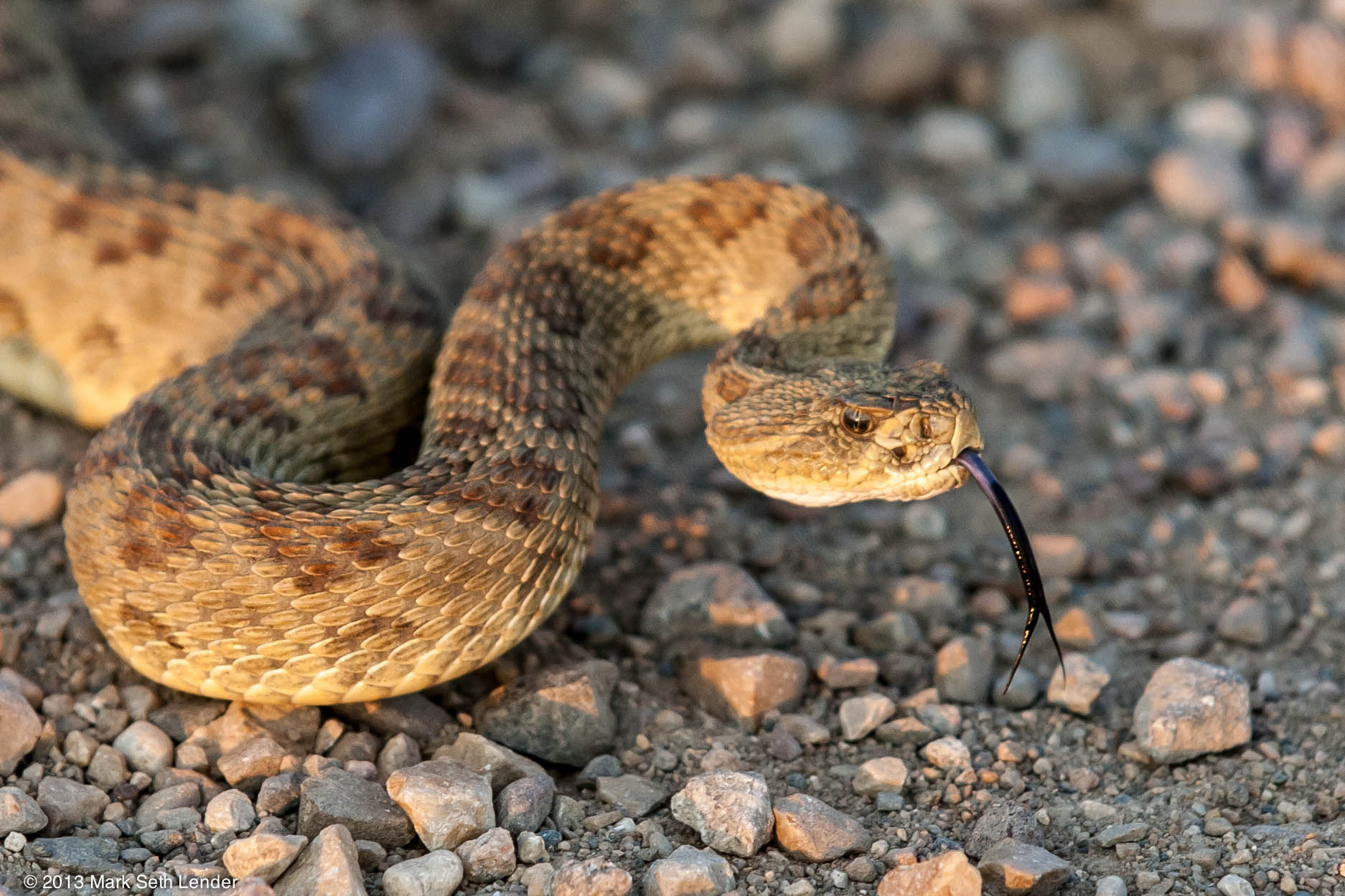
The Prairie Rattlesnake has a black tongue (photo: Mark Seth Lender)
CURWOOD: For many people, snakes provoke shudders and an urge to run the other way, especially if the one you encounter is venomous, like the Prairie Rattlesnake. But deadly or not, this rattlesnake is typically not aggressive and would rather just slither away when it encounters humans. A few months age writer Mark Seth Lender met his first prairie rattler in Grasslands National Park and found the creature strangely engaging.
LENDER: Prairie Rattlesnake lying in the road, down in the dust, warming her bones. I lie down just across the way to look her in the eye. She stares right back, and only raises her head when I shimmy up - too close! - and only coils (and then not all the way) when with too much haste I try to hurry her on, before the next car comes.
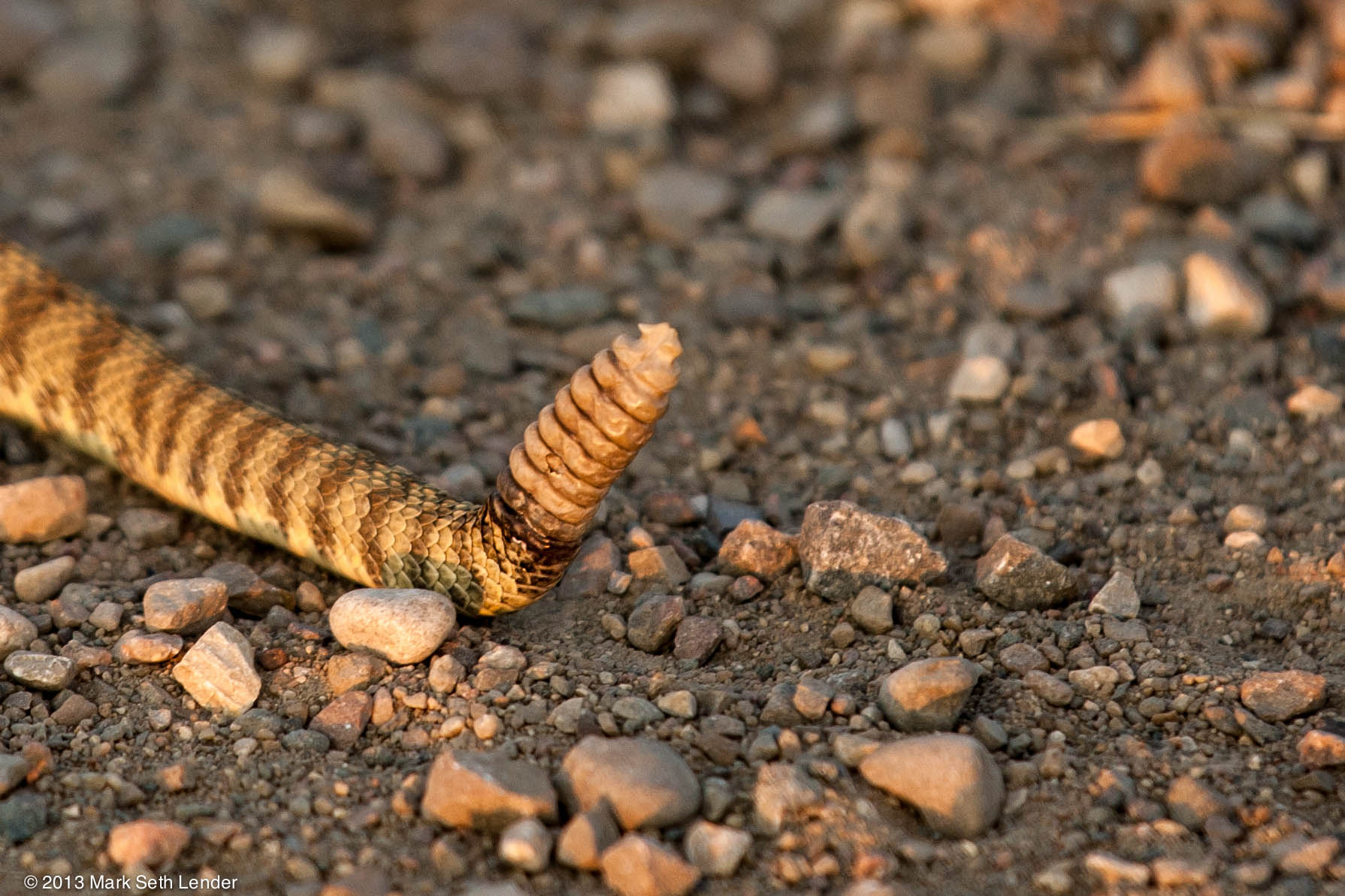
The Prairie Rattler’s instrument (photo: Mark Seth Lender)
She shows me her rattle, without one tick, and sticks out her tongue from the jet black tip to the velvety purple top to taste the curious scent of me. Better if that’s where the story ends…
Rattlesnake bites you? You’re gonna lie right down and dance. Shake and roll all over the place. Dirt in your hair, fear in your face. Ain’t no use yellin’ for help; shoulda put your foot down somewhere else. Shoulda listened, shoulda changed course. Snake rattles? That’s her only voice. Take a hint, take her lead: put your hands in your pockets, hike up your pants, jump on your ride and take yourself back.

Prairie Rattlesnake on its guard (photo: Mark Seth Lender)
Snake just wants to get away from you.
With horror we watch rattlesnake consume her prey. The rabbit, completely still, vanishing with inexorable slowness down and down, the snake undulating with what seems like terrible pleasure. Is that not true of you seated at your overflowing bowl and groaning board? True upon the supermarket shelves and at the corner store?
What of the fungi the rattler crawls through at the dark beginning of her day. The fish in the pool gasping at the surface when the snake swam through to cool her bones in the long heat of the afternoon. Not just the lamb that was the flesh upon your plate but the wine that was the grape, seeds that were ground that you may break bread, the flower that became the saffron in your rice, and the rice, and the aged porcelain with which the potter made the plate; when fire fused the glaze it burned invisible things, uncountable. Even the ant, automaton of genes, of habit, and the chemistry of scent, and down in the weeds also what the ant eats.
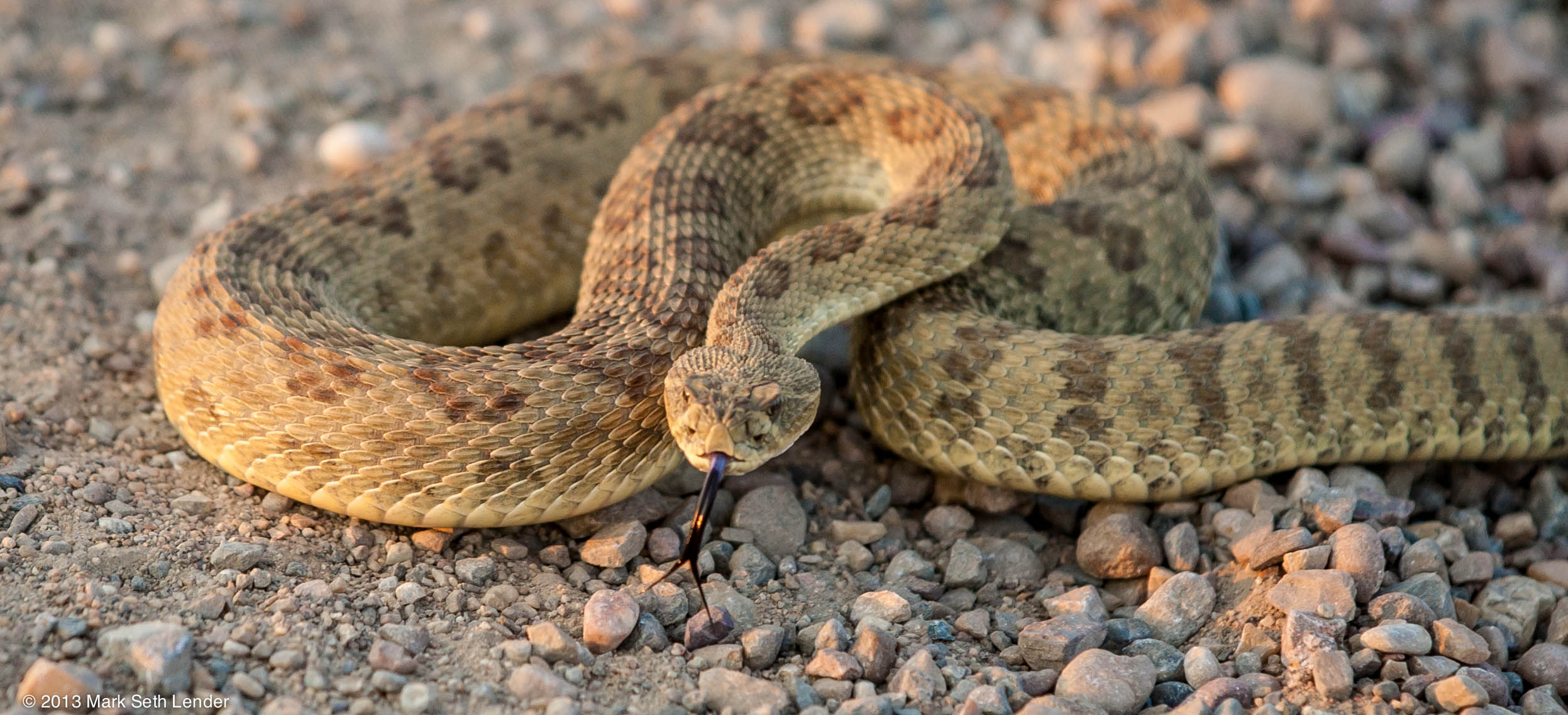
(photo: Mark Seth Lender)
All want to keep on living.
Rattlesnake would tell it like this: “On a stone set by itself you may find fresh in the sun my shed skin (rattlesnake growing and prospering). Take it is a sign: Like you I passed this way.”
[PRAIRIE RATTLESNAKE RATTLING]
CURWOOD: Mark Seth Lender recorded this warning from the prairie rattler.
To see some of Mark’s close-ups of a prairie rattlesnake, slink on over to our website, LOE.org.
Related links:
- Check out more at Mark Seth Lender’s website
- If you’re interested in visiting Grasslands National Park contact Mark Seth Lender at MSL@MarkSethLender .com
[MUSIC: Jim Jamm Jimmy “Rattlesnake” from #1 Contender (Jim Jamm Jimmy Records)]
CURWOOD: Next time on Living on Earth, visiting Fukushima nearly three years after the nuclear catastrope.
ROTHBART: I learned this word called "gaman", which translates sort of loosely as stoicism but it's much deeper than that - it's sort of taking pride in being able to survive any situation.
CURWOOD: Some Japanese are hanging on there without complaint. That's next time on Living on Earth.
CURWOOD: Living on Earth is produced by the World Media Foundation. Naomi Arenberg, Bobby Bascomb, Emmett Fitzgerald, Helen Palmer, Adelaide Chen, James Curwood, Jennifer Marquis and Gabriela Romanow all help to make our show. Jeff Turton is our technical director. Alison Lirish Dean composed our themes. You can find us anytime at LOE.org, and like us on our Facebook page - it’s PRI’s Living on Earth. And we tweet from @LivingOnEarth. I'm Steve Curwood. Thanks for listening.
ANNOUNCER 1: Funding for Living on Earth comes from the Grantham Foundation for the protection of the environment. Supporting strategic communications and collaboration in solving the world’s most pressing environmental problems. The Kendeda Fund, furthering the values that contribute to a healthy planet, and Gilman Ordway for coverage of conservation and environmental change. Living on Earth is also supported by a friend of The Nation, where you can read such environmental writers as Gwen Stevenson, Bill McKibben, Mark Hertzgaard and others at TheNation.com. This is PRI, Public Radio International.
ANNOUNCER 2: PRI, Public Radio International.
Living on Earth wants to hear from you!
Living on Earth
62 Calef Highway, Suite 212
Lee, NH 03861
Telephone: 617-287-4121
E-mail: comments@loe.org
Newsletter [Click here]
Donate to Living on Earth!
Living on Earth is an independent media program and relies entirely on contributions from listeners and institutions supporting public service. Please donate now to preserve an independent environmental voice.
NewsletterLiving on Earth offers a weekly delivery of the show's rundown to your mailbox. Sign up for our newsletter today!
 Sailors For The Sea: Be the change you want to sea.
Sailors For The Sea: Be the change you want to sea.
 The Grantham Foundation for the Protection of the Environment: Committed to protecting and improving the health of the global environment.
The Grantham Foundation for the Protection of the Environment: Committed to protecting and improving the health of the global environment.
 Contribute to Living on Earth and receive, as our gift to you, an archival print of one of Mark Seth Lender's extraordinary wildlife photographs. Follow the link to see Mark's current collection of photographs.
Contribute to Living on Earth and receive, as our gift to you, an archival print of one of Mark Seth Lender's extraordinary wildlife photographs. Follow the link to see Mark's current collection of photographs.
 Buy a signed copy of Mark Seth Lender's book Smeagull the Seagull & support Living on Earth
Buy a signed copy of Mark Seth Lender's book Smeagull the Seagull & support Living on Earth

